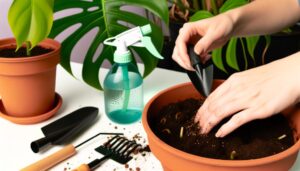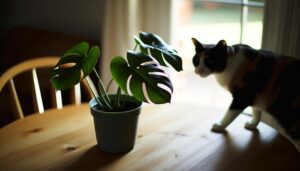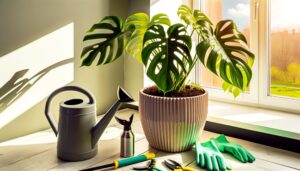How Often to Water Monstera Plant? Expert Advice!
Water your Monstera every 7-10 days in spring and summer, and every 2-3 weeks in autumn and winter. Use lukewarm water and let soil partially dry between waterings.
Pay attention to your Monstera’s environment, maintaining bright, indirect light and 60-80% humidity. A pot with drainage holes and terracotta material can assist in moisture control.
Substrate mix with perlite and bark chips also helps prevent root rot. Observe for yellowing leaves or mushy stems as signs of overwatering, or drooping and crispy edges for underwatering.
Staying alert to these details guarantees your plant thrives. Discover more expert tips for maintaining a healthy Monstera.
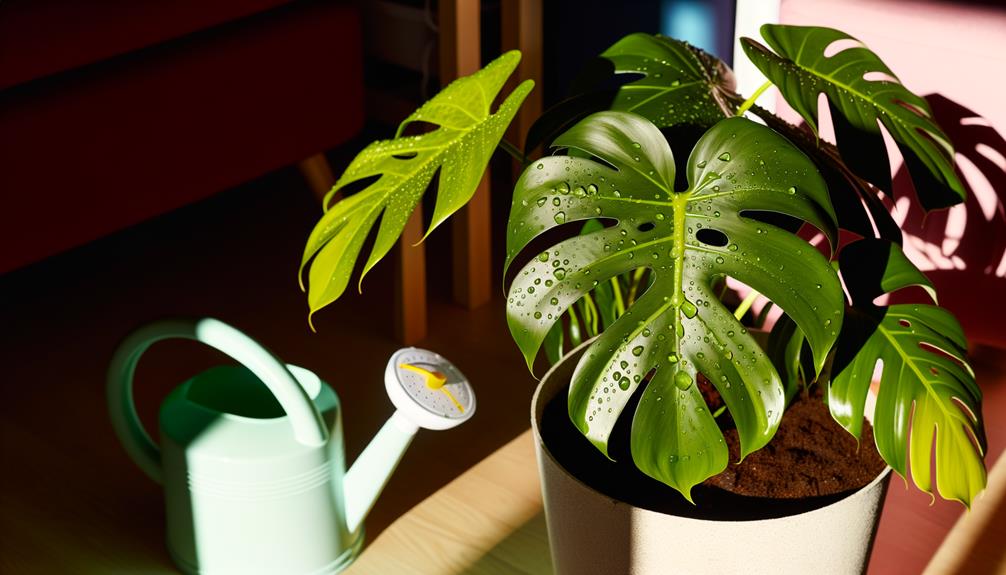
Key Takeaways
- Water Monstera every 7-10 days in spring and summer.
- Reduce watering frequency to every 2-3 weeks in autumn and winter.
- Ensure soil partially dries out between waterings to prevent root rot.
- Use lukewarm, room temperature water for best absorption.
- Adjust watering based on indoor humidity and seasonal growth changes.
Understanding Monstera’s Needs
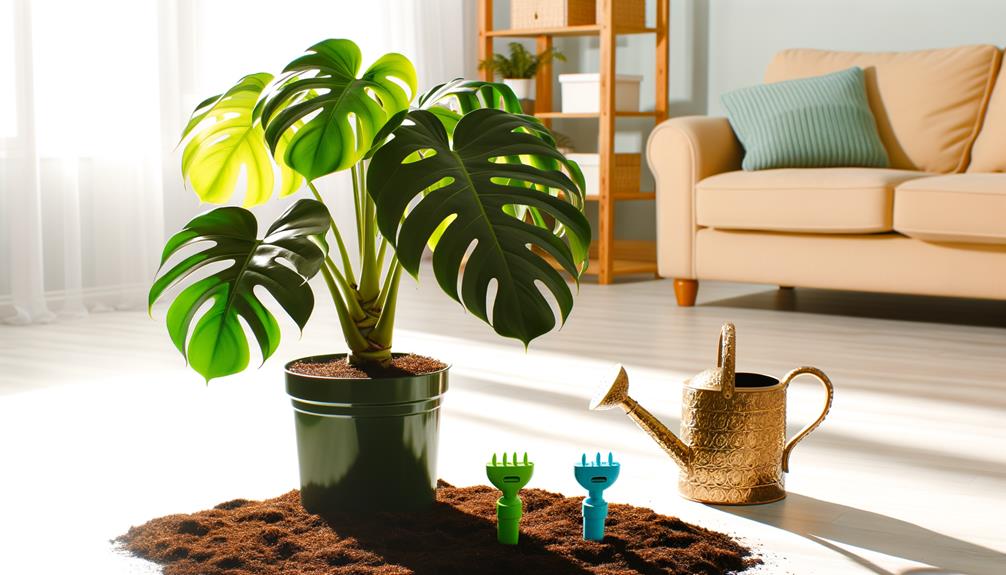
Understanding Monstera’s needs begins with recognizing its tropical origins, which dictate its preference for high humidity and indirect sunlight. Native to the rainforests of Central America, Monstera thrives in environments that mimic these conditions.
You’ll need to maintain humidity levels around 60-80% to keep your plant happy. Regular misting or using a humidifier can help achieve this.
Additionally, Monstera prefers bright, indirect light; direct sunlight can scorch the leaves. Aim for a location with filtered light or place the plant near a north or east-facing window. Monstera’s large, fenestrated leaves are designed to capture diffused light, so proper placement is essential.
Assessing Your Environment
To assure your Monstera plant flourishes, start by carefully evaluating the microclimate of your home, paying particular attention to light levels, humidity, and temperature fluctuations. Monstera thrive under specific conditions, so understanding your environment is essential.
- Light Levels: Aim for bright, indirect light. Direct sunlight can scorch the leaves, while too little light hampers growth.
- Humidity: Ideal humidity is around 60%. Use a hygrometer to monitor and consider a humidifier if levels are too low.
- Temperature: Maintain a stable temperature between 65-85°F. Avoid placing the plant near drafts or heating vents.
- Air Circulation: Ensure good airflow to prevent fungal issues. A small fan can help circulate air if your space is stagnant.
Choosing the Right Pot
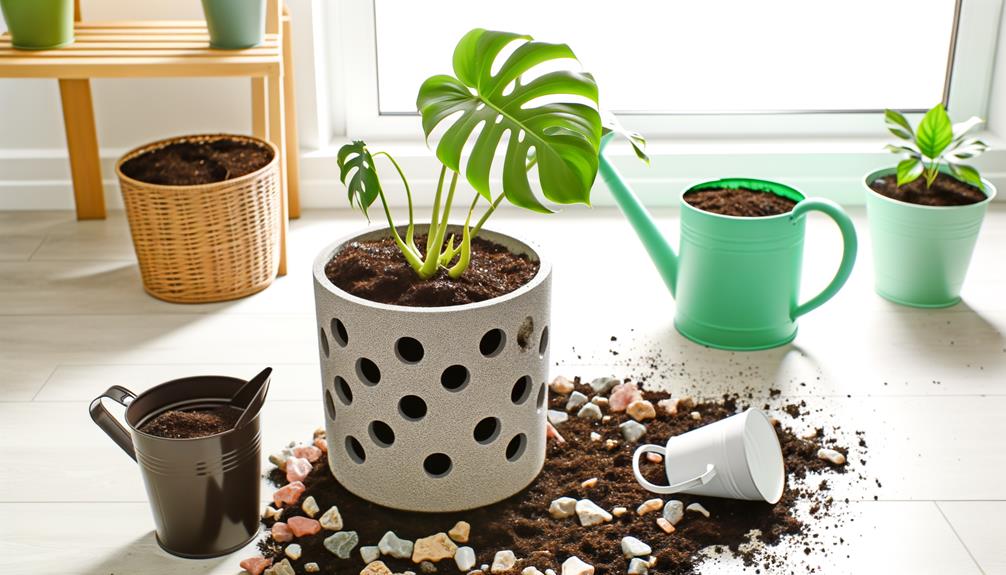
When selecting a pot for your Monstera, it’s important to have adequate drainage holes to prevent root rot and promote aeration. Opt for materials like terracotta that offer breathability, and choose a size that accommodates growth without being overly large.
Proper pot selection greatly influences water retention and plant health.
Drainage and Aeration
Your Monstera’s health heavily relies on selecting a pot that provides excellent drainage and aeration. Ensuring proper drainage prevents waterlogging, which can lead to root rot, while good aeration supports healthy root growth. When choosing a pot, look for features that facilitate these needs.
- Drainage Holes: Select a pot with multiple drainage holes to allow excess water to escape efficiently.
- Material: Opt for pots with porous materials like terracotta that promote breathability.
- Size: Choose a pot size that offers room for growth but isn’t overly large, which can retain too much moisture.
- Elevated Base: Consider pots with an elevated base or use pot feet to enhance airflow and prevent water accumulation.
Pot Material Matters
Selecting the correct pot material is essential for ensuring your Monstera thrives, as it directly influences moisture retention and root health.
Terra cotta pots are highly breathable, allowing excess moisture to evaporate, which helps prevent root rot. However, they require more frequent watering.
On the other hand, plastic pots retain moisture longer, reducing the frequency of watering but increasing the risk of overwatering.
Ceramic pots offer a middle ground, providing some breathability while retaining moisture better than terra cotta. Make sure the pot has drainage holes to avoid waterlogged soil.
The material you choose will impact your watering routine, so consider your environment and watering habits carefully. This balance is important for maintaining ideal soil moisture levels.
Size and Growth
Choosing the proper pot size is crucial for accommodating the Monstera’s growth and guaranteeing it has ample space for root expansion.
A pot that’s too small can hinder root growth, leading to poor plant health. Conversely, an excessively large pot can retain excess water, increasing the risk of root rot.
Here are key considerations for selecting the suitable pot:
- Pot Diameter: Select a pot with a diameter 2-4 inches larger than the current one to allow for growth.
- Drainage: Make sure the pot has ample drainage holes to prevent water accumulation.
- Material: Choose breathable materials like terracotta to facilitate air movement.
- Stability: A heavier pot can offer stability for the Monstera’s expanding foliage.
Understanding these factors will optimize your Monstera’s health and growth.
Importance of Potting Mix
You need to understand that the potting mix you choose for your Monstera is essential for its health.
A well-aerated soil enhances root respiration, while proper drainage and moisture control prevent root rot.
Additionally, the right mix guarantees ideal nutrient retention, supporting vigorous growth.
Soil Aeration Benefits
A well-aerated potting mix is crucial for Monstera plants as it ensures proper root respiration and prevents waterlogging. When the soil has sufficient air spaces, it allows oxygen to reach the roots, promoting healthy growth and nutrient uptake.
To guarantee your Monstera benefits from soil aeration, consider these key components:
- Perlite: This volcanic glass improves drainage and keeps the soil light.
- Bark Chips: Adding these provides structure and air pockets, supporting root health.
- Pumice: This lightweight stone enhances aeration and retains some moisture.
- Coconut Coir: It enhances water retention while still allowing for good air flow.
Using these materials in your potting mix helps maintain an ideal environment for your Monstera, enhancing its overall well-being.
Drainage and Moisture Control
Effective drainage and moisture control in the potting mix are paramount to preventing root rot and ensuring your Monstera thrives. You’ll want a mix rich in organic matter, like peat moss or coco coir, which retains moisture but also provides aeration.
Adding perlite or pumice improves drainage, preventing water from stagnating around the roots. Make sure your pot has adequate drainage holes to allow excess water to escape.
Monitor the moisture levels by inserting your finger about an inch into the soil; water only when it feels dry. A moisture meter can provide more precise measurements. Remember, overwatering is more detrimental than underwatering, as it leads to root rot.
Balancing these elements will keep your Monstera healthy and vigorous.
Nutrient Retention Factors
In order to achieve the best nutrient retention for your Monstera, selecting a high-quality potting mix that’s well-balanced in organic materials and essential nutrients is crucial. You need a mix that supports proper aeration and drainage while holding onto moisture and nutrients.
Here’s what to look for:
- Organic Matter: Include compost or peat moss to boost nutrient content and water retention.
- Aeration: Perlite or orchid bark guarantees good airflow, preventing root rot.
- Moisture Control: Coco coir helps sustain consistent moisture levels.
- pH Balance: Aim for a slightly acidic to neutral pH (5.5-7) to optimize nutrient uptake.
Seasonal Watering Guide
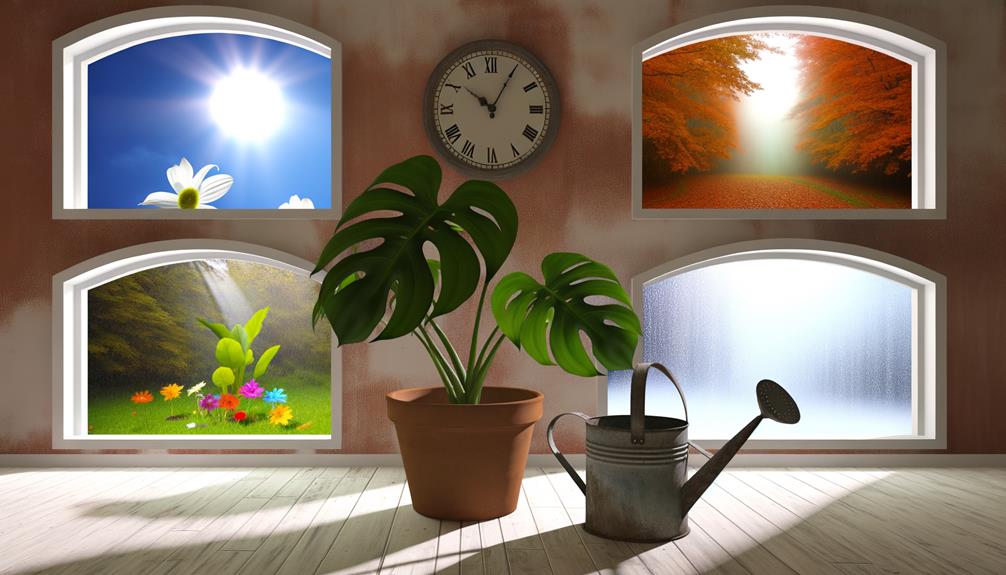
Understanding how to adjust your watering schedule for a Monstera plant throughout the year guarantees ideal growth and health.
During spring and summer, when the plant is in its active growth phase, water your Monstera every 7-10 days, making sure the top inch of soil is dry before you water again.
In autumn and winter, reduce watering frequency to every 2-3 weeks, as growth slows and the plant enters dormancy.
Always use lukewarm water to prevent root shock, and ensure proper drainage to avoid waterlogged soil.
Monitor humidity levels and mist the leaves occasionally to mimic the Monstera’s natural tropical habitat.
Signs of Overwatering
While adjusting your watering schedule is important, recognizing the signs of overwatering is equally critical to maintaining your Monstera plant’s health.
Overwatering can lead to root rot, which compromises the plant’s ability to absorb nutrients and water.
To prevent this, be vigilant for these indicators:
- Yellowing Leaves: Excessive water can cause leaves to turn yellow, particularly the lower ones.
- Wilting Despite Moist Soil: If the soil is consistently wet, yet the plant appears wilted, it’s a red flag.
- Mushy Stems: Overwatered stems might become soft and mushy, indicating root damage.
- Foul Odor: A sour or musty smell from the soil suggests bacterial or fungal growth due to waterlogged conditions.
Detect these signs early to adjust your care routine accordingly.
Signs of Underwatering
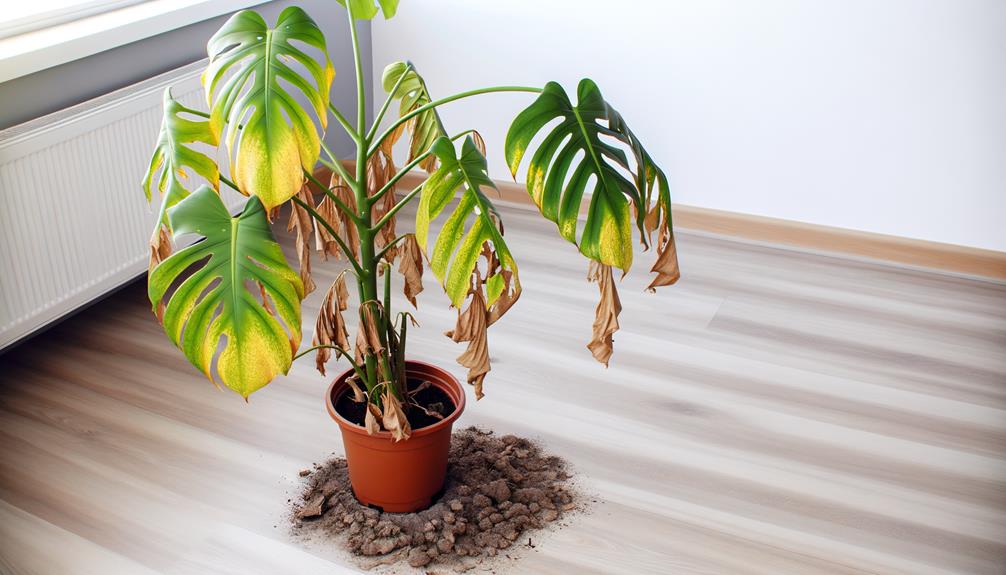
Detecting signs of underwatering in your Monstera plant is crucial to ensure it thrives and maintains its lush, vibrant appearance. Look for drooping leaves, a common indicator that your plant isn’t receiving sufficient moisture.
Additionally, check for brown, crispy edges on the leaves, which signal dehydration. The soil will often be dry to the touch, pulling away from the edges of the pot.
You may also notice slower growth, as the plant conserves energy under water stress. Yellowing leaves, particularly those lower on the plant, can also indicate a lack of water.
Regularly monitor these signs to guarantee timely intervention, preventing long-term damage and promoting peak health for your Monstera.
Humidity’s Role
Maintaining ideal humidity levels is essential for your Monstera plant’s health, as it mimics its natural tropical habitat and supports robust growth. Aim for humidity levels between 60-80%.
Insufficient humidity can cause leaf edges to brown and curl, while excessive humidity can promote fungal growth.
To manage humidity effectively:
- Humidifier: Use a humidifier near your plant to maintain consistent humidity levels.
- Pebble Tray: Place the pot on a tray filled with water and pebbles to increase ambient moisture.
- Misting: Regularly mist the leaves with water, ensuring you do it in the morning to prevent overnight dampness.
- Room Placement: Avoid placing your Monstera near heating vents or air conditioners, as they can drastically reduce humidity.
Light Exposure Impact
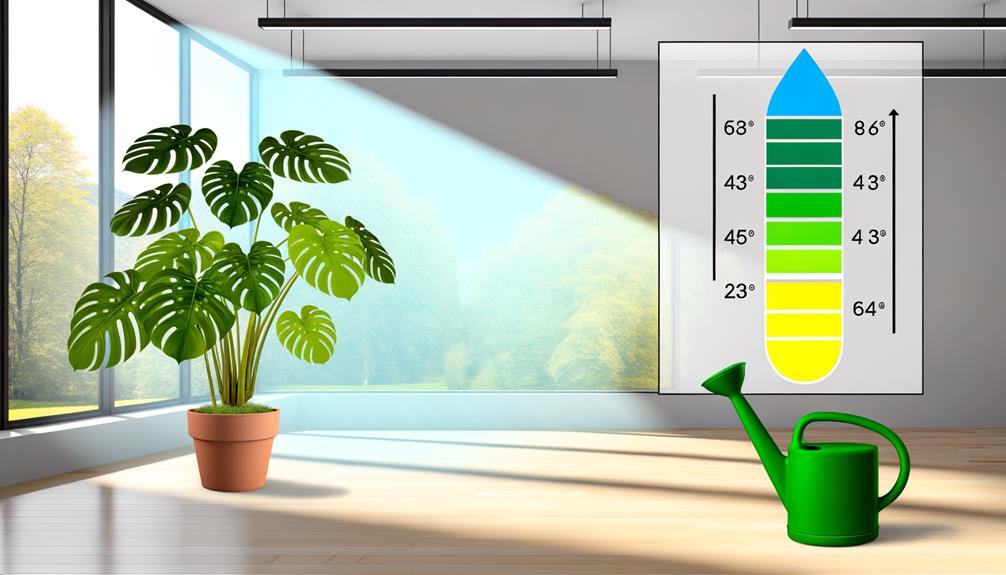
Proper humidity is important, but equally vital is guaranteeing your Monstera receives the right light exposure to thrive. Monstera plants flourish in bright, indirect light. Direct sunlight can scorch their leaves, while insufficient light leads to slower growth and smaller leaves.
Position your Monstera near an east-facing window for optimal morning light or a few feet back from a south or west-facing window to avoid direct rays. Light intensity directly impacts the plant’s transpiration rate, influencing how often you should water.
In low light, soil retains moisture longer, requiring less frequent watering. Conversely, in brighter conditions, increased transpiration will demand more regular hydration. Monitor leaf color and growth patterns to adjust placement and ensure balanced light exposure.
Watering Techniques
Mastering precise watering techniques that cater to its specific needs is essential for your Monstera plant to thrive. Begin by using room-temperature water to avoid shocking the roots.
Water thoroughly until excess drains out the bottom, guaranteeing even moisture distribution. Allow the soil to partially dry before the next watering cycle to prevent root rot.
Here’s a step-by-step guide:
- Water Quality: Use filtered or distilled water to avoid mineral buildup.
- Water Timing: Water in the morning to maximize absorption and minimize fungal growth.
- Soil Check: Insert your finger about an inch into the soil; water only if it feels dry.
- Drainage: Confirm your pot has adequate drainage holes to prevent waterlogging.
Using Moisture Meters
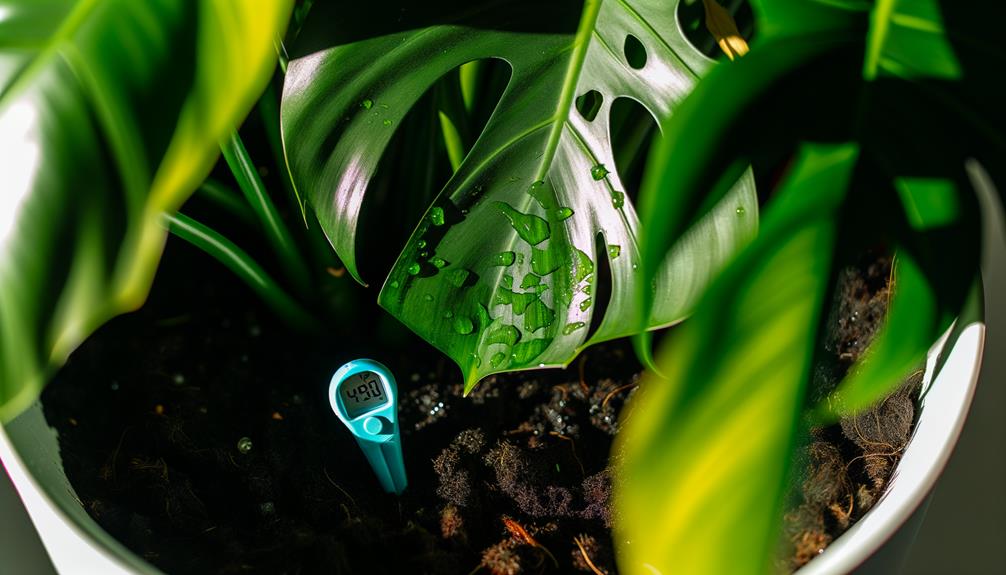
Using a moisture meter lets you precisely gauge the soil’s moisture levels, ensuring your Monstera gets ideal hydration.
Insert the probe to the root zone and read the meter to determine if watering is necessary.
Aim for a soil moisture level that consistently reads between 4 and 6 for peak plant health.
Reading Moisture Levels
With a moisture meter, you can accurately gauge the soil’s hydration levels, ensuring your Monstera plant receives the most suitable amount of water.
To use a moisture meter effectively, follow these steps:
- Insert the Probe: Place the moisture meter’s probe about halfway between the stem and the edge of the pot, deep enough to reach the root zone.
- Read the Scale: Check the meter’s scale, which typically ranges from 1 (dry) to 10 (wet). Aim for a reading around the middle range.
- Adjust Watering: If the reading is low, water your Monstera. If it’s high, hold off.
- Regular Monitoring: Test the soil moisture every few days to maintain the most suitable hydration levels.
Using a moisture meter minimizes guesswork and promotes healthier plant growth.
Optimal Soil Moisture
Achieving perfect soil moisture for your Monstera involves consistently monitoring the moisture meter readings to maintain a balanced hydration level that supports robust growth. Insert the probe into the soil about halfway between the plant’s base and the pot’s edge.
Aim for a moisture reading between 3 and 4 on a 1 to 10 scale. This range indicates that the soil is moist but not waterlogged, minimizing root rot risk. Check the meter weekly and adjust watering frequency accordingly.
If the reading falls below 3, it’s time to water. Conversely, readings above 4 suggest you should wait before the next watering. Employing this method guarantees your Monstera receives precise, best moisture levels conducive to healthy development.
Common Mistakes to Avoid
One of the most common mistakes when watering a Monstera plant is failing to maintain proper drainage, which can lead to root rot and other health issues. To avoid this, make sure your pot has drainage holes and a well-draining soil mix.
Additionally, overwatering and underwatering are pitfalls to watch out for.
Here are four key mistakes to avoid:
- Using a pot without drainage holes: This traps excess water, suffocating roots.
- Watering based on a set schedule: Instead, check soil moisture regularly.
- Neglecting seasonal changes: Monstera needs less water in winter.
- Failing to adjust for humidity: High humidity means less frequent watering.
Conclusion
While watering your Monstera can seem straightforward, it’s a balance of science and art.
Overwatering suffocates roots, while underwatering leads to a thirsty, stressed plant.
By understanding your environment, selecting the right pot, and using a well-draining mix, you create the perfect conditions.
Seasonal adjustments and light exposure nuances further refine your approach.
Embrace moisture meters for precision, but remember, intuition is invaluable.
Avoid common mistakes, and your Monstera will thrive, combining expert care with nature’s resilience.

